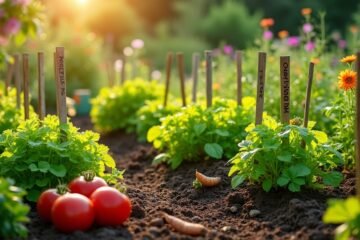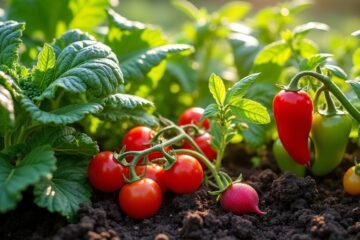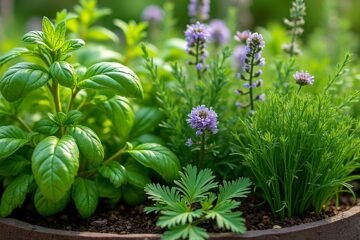Want to grow fresh veggies in containers? First, choose vibrant pots—think terracotta! Next, fill them with rich, organic soil. Don’t forget to mix in some compost for that extra oomph! Pair herbs like basil with tomatoes for a flavorful feast, and use drip irrigation for sweet, hydrated plants. Keep an eye out for pesky pests, and make sure to harvest your crops promptly for peak freshness. Excited to learn more techniques for your green thumb?
Choosing the Right Containers
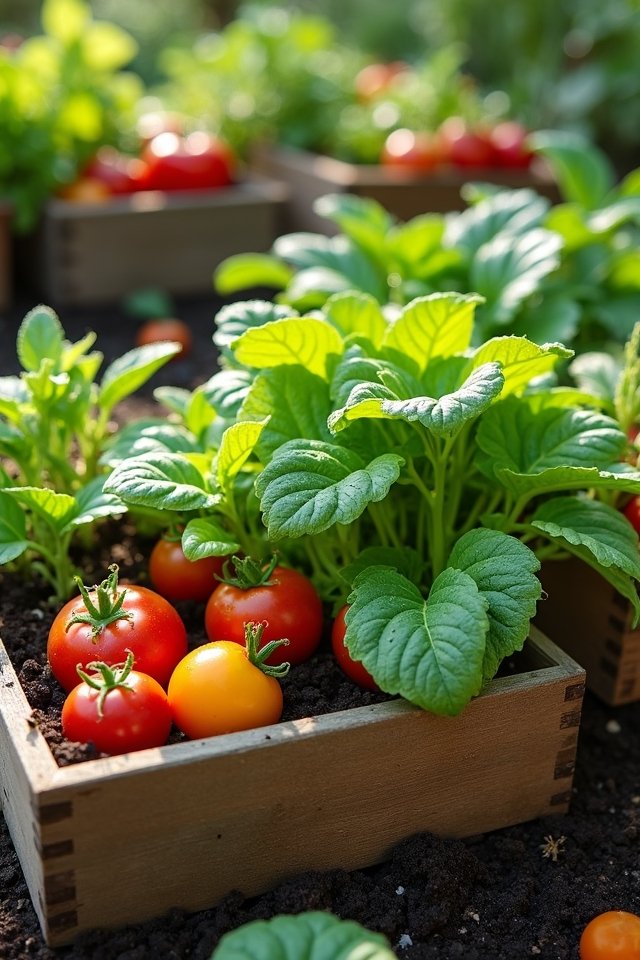
When it comes to choosing the right containers, you’ve got a world of options at your fingertips! From chic terracotta pots to durable plastic bins, container materials can elevate your gardening game. Do you want lightweight or traditional? Consider those options carefully! Container sizes matter too; you wouldn’t put a giant zucchini in a teacup, right? Choose spacious pots for larger veggies and smaller ones for herbs!
Imagine lush basil peeking from a stylish sea-green container. Isn’t that a sight? Plus, various sizes allow you to creatively arrange your garden, turning a small balcony into a vibrant oasis! So, plunge into those choices and find what fits your style—your plants will thank you for it! Happy gardening!
Selecting Organic Soil and Amendments
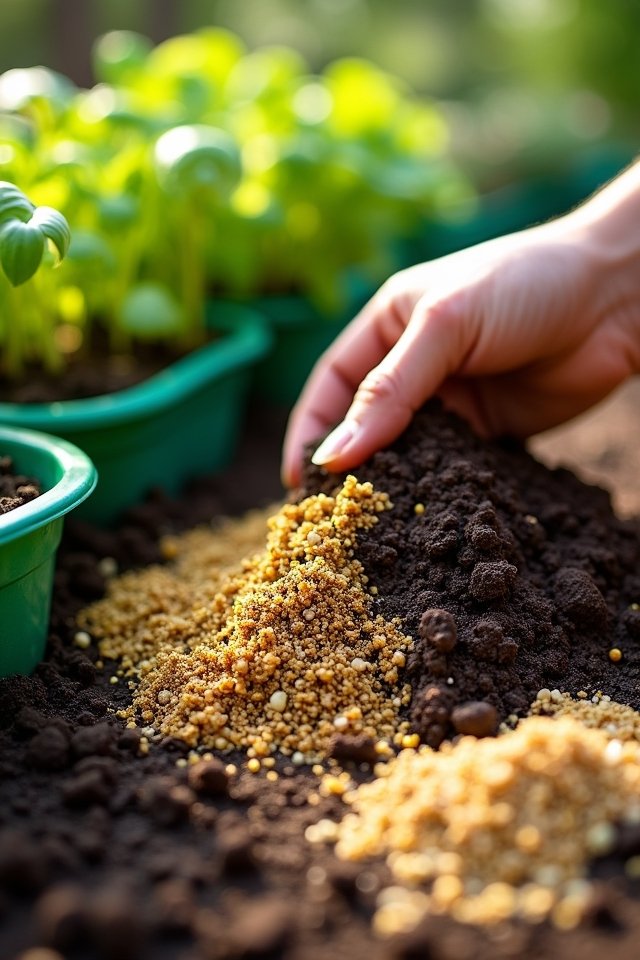
Selecting the perfect organic soil and amendments is like finding the right outfit for a big event—it sets the stage for greatness! Start with soil testing to understand what your plants crave. Think of it as a personal shopping experience for nutrients! You’ll want a well-draining mix, rich in organic matter. Try blending compost, worm castings, and coconut coir for that soft, fluffy texture plants love. Don’t forget organic amendments! Things like bone meal or fish emulsion pack a punch of nutrients that keep your veggies thriving. It’s like feeding them a gourmet meal! So, when you mix your soil, imagine you’re crafting a masterpiece—each ingredient plays its role in ensuring a bountiful harvest. Go for it!
Implementing Companion Planting
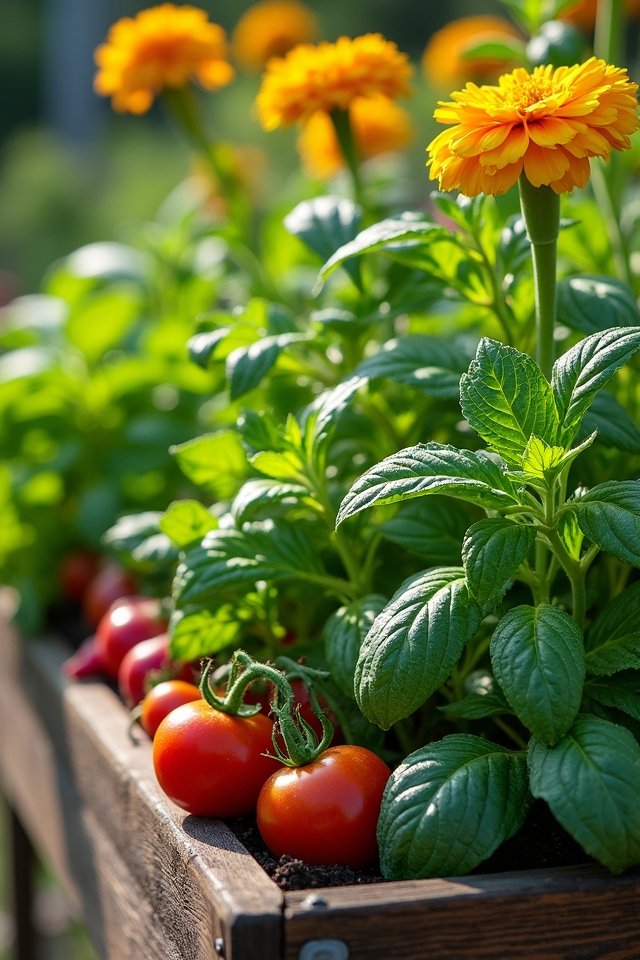
Imagine walking through your vegetable garden and discovering a spectacular community of plants working together like a well-rehearsed orchestra, each one playing its part to perfection! Implementing companion planting is key, and you’ll love the magic of smart plant pairings. For instance, pairing basil with tomatoes not only boosts flavors, but also keeps pesky pests at bay. Explore the biodiversity benefits, allowing your containers to become vibrant ecosystems where various plants thrive together. You might find carrots and radishes competing for space, but they’ll actually enhance each other’s growth! So, go ahead, mix and match! It’s not just gardening; it’s creating an innovation-driven symphony that benefits you and Mother Nature! Are you ready to transform your garden into a masterpiece?
Utilizing Raised Bed Techniques in Containers
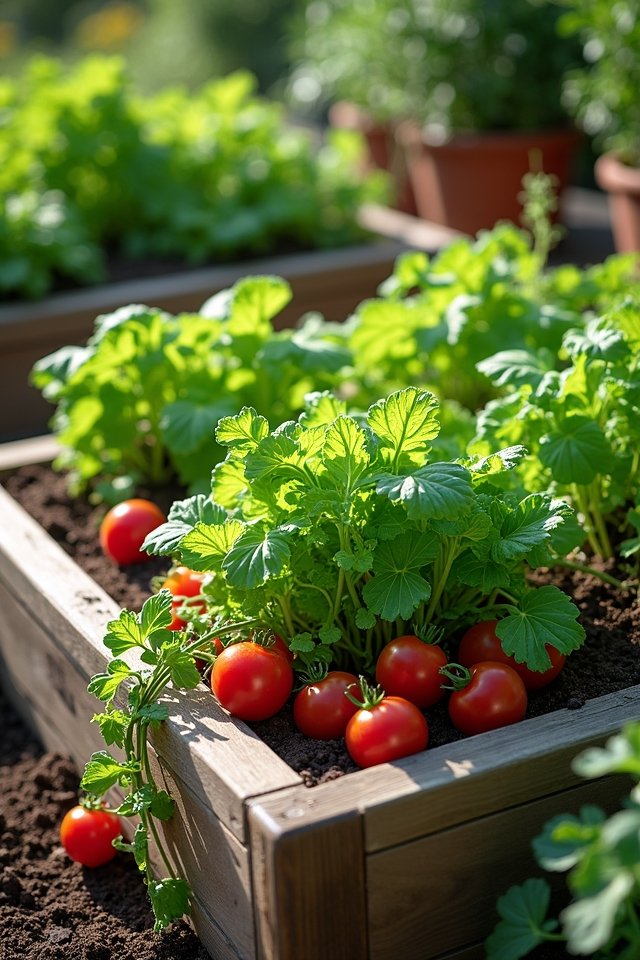
You’ve probably heard of raised beds for traditional gardens, but did you know you can adapt those brilliant techniques for your container gardening? Imagine transforming your urban balcony into a lush vegetable paradise! Raised bed principles work wonders in pots. You can stack containers for height and depth, mimicking the soil-rich environment of a raised bed while ensuring easy access. Pair deep-rooted veggies, like tomatoes, with shallow-rooted herbs in a single container—talk about container compatibility! Layer your soil with compost for that rich, earthy aroma, and don’t forget to add smart drainage. Make this innovative approach your secret weapon! So, release your creativity and watch those veggies thrive in their cozy container homes! Ready to dig in? Let’s go!
Effective Watering Strategies
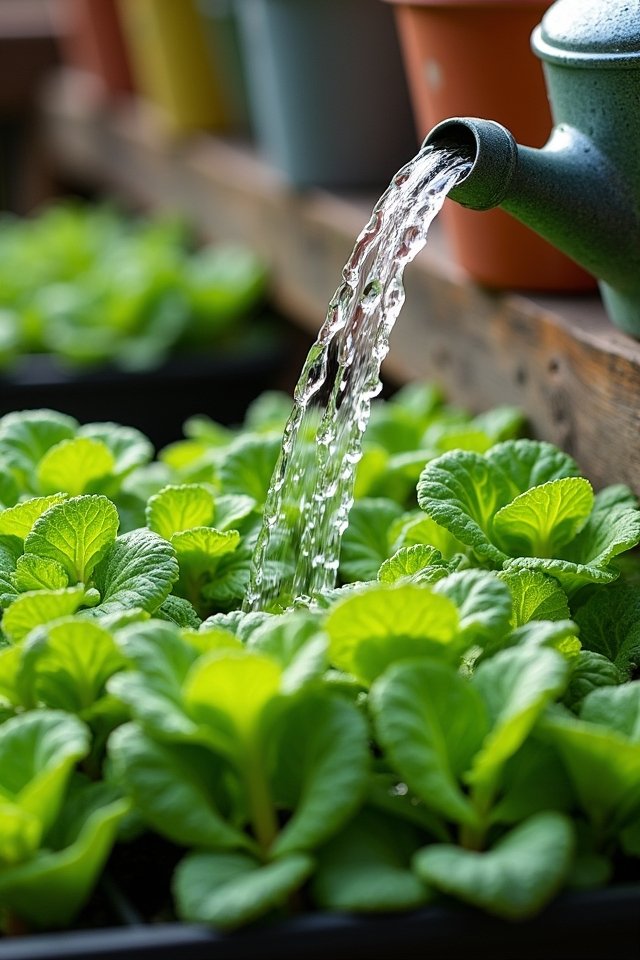
Once you’ve set up those vibrant containers, keeping your veggies hydrated is downright essential! You’ll want to guarantee your plants flourish, so welcome these effective watering strategies:
- Use drip irrigation to deliver water directly to the roots, like a cozy blanket of moisture!
- Mulch your containers to enhance moisture retention, just like a sponge soaking up every last drop!
- Water early in the morning to prevent evaporation—think of it as a revitalizing breakfast for your plants!
- Check moisture levels regularly; stick your finger in the soil—if it’s dry, time to hydrate!
- Rotate your watering methods, mixing between deep-soaking and gentle spritzing for a balanced approach!
Your veggies will thank you with fruitful bounty! Keep that love flowing!
Organic Pest Control Methods
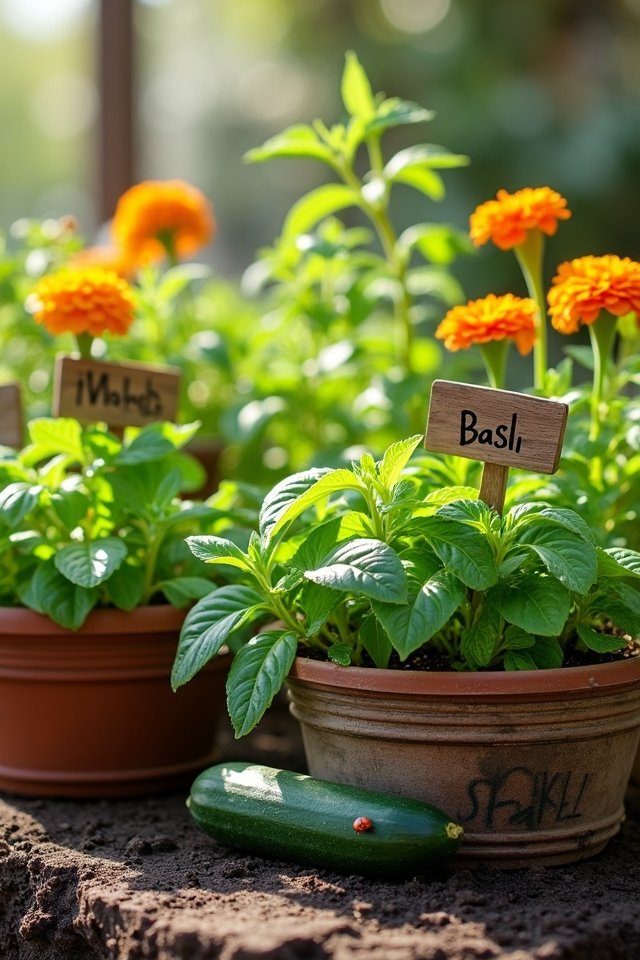
While pests can be pesky little troublemakers, tackling them organically can keep your veggie haven thriving! Welcome natural remedies like neem oil, a superstar in repelling unwanted visitors. Get creative with homemade sprays combining garlic and chili—those bugs won’t know what hit ’em! You can also invite beneficial insects, like ladybugs and lacewings, for a team-up against aphids and caterpillars. These little allies are nature’s secret weapons! Regularly inspect your plants, sweeping away any pesky spider mites or slugs—think of it as a garden treasure hunt! Remember, prevention is your best friend; keep your plants healthy, and they’ll naturally resist pests. A bountiful harvest is just a few clever strategies away, so let’s keep those bugs at bay!
Utilizing Fertilizers and Nutrients
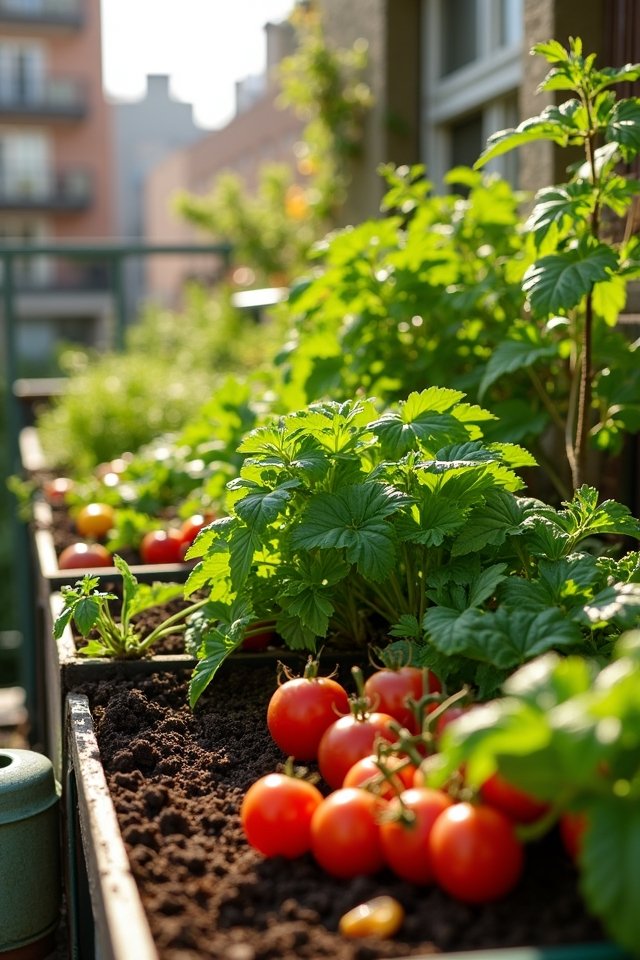
When it comes to growing vibrant veggies, nourishing your plants with the right fertilizers and nutrients is like giving them a hearty breakfast before a big day! You’ll want to maintain that perfect nutrient balance, ensuring your plants thrive. Try these innovative techniques:
- Use organic fertilizers to help your plants absorb nutrients naturally.
- Brew some compost tea for a delicious microbial boost!
- Experiment with slow-release options for steady nourishment.
- Don’t skip soil testing; knowing your soil’s needs is key!
- Explore foliar feeding and mineral supplements to enhance growth!
With these approaches, you’ll elevate your container garden, fostering luscious leaves and robust roots. Enjoy the earthy satisfaction of watching your plants flourish! What could be more rewarding?
Optimizing Sunlight Exposure
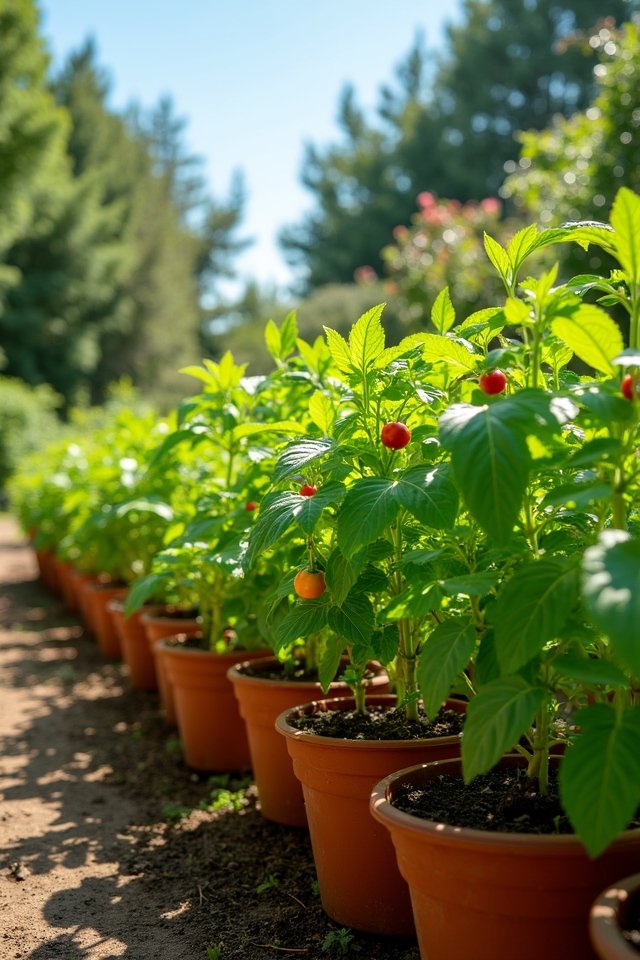
To truly make your container vegetable garden thrive, you’ll want to play a clever game of sun tag! Think of sunlight angles as your garden’s best friends—some plants adore a full sun bath, while others just need a flirt with the sun. Monitor sunlight throughout the day, and adjust your pots accordingly, so everyone gets the light they crave!
But hold on! Shade management is key, too. Position taller plants to cast leafy shadows over their shorter, sun-hungry neighbors. You might even try rotating containers to maximize sun exposure. Experiment with different arrangements—it’s like a garden dance! Remember, a little innovation keeps things fresh and exciting. So grab your pots, channel your inner sunlight wizard, and watch your veggies thrive!
Crop Rotation in Container Gardening
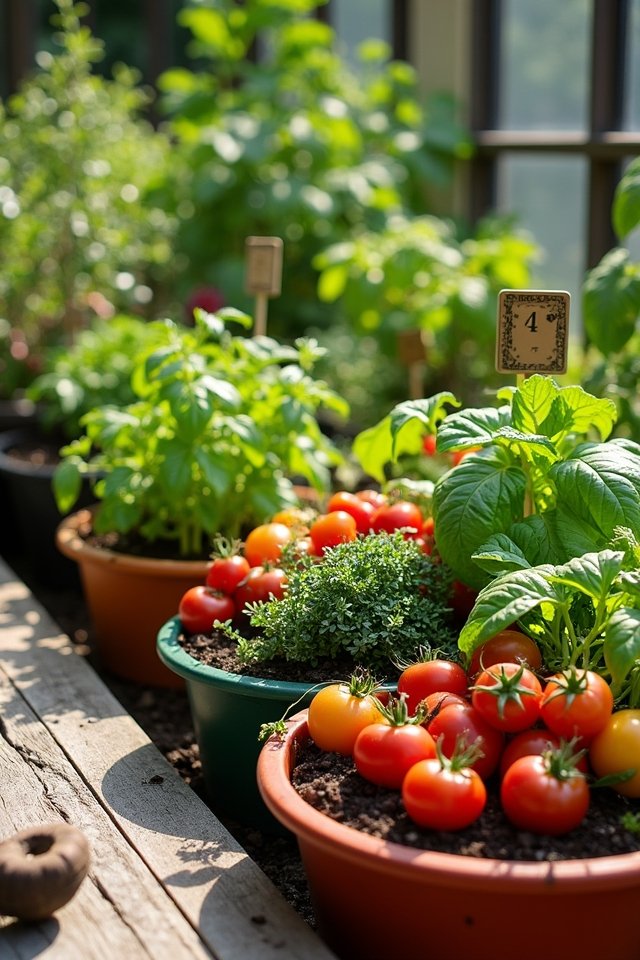
Now that you’ve got your plants basking in the sun just right, let’s talk about the clever art of crop rotation in container gardening! You might think it’s only for large farms, but this technique is perfect for your cozy container setup. By shifting your seasonal planting, you can keep your soil in tip-top shape and maximize container diversity! Here’s how you can get started:
- Rotate crops by their family—like tomatoes and peppers!
- Choose a different spot for your containers each season.
- Mix leafy greens with root veggies for balance.
- Use companion planting to ward off pests.
- Keep a journal to track your rotations and success!
With a bit of planning, you’ll harness the power of your garden like never before!
Harvesting and Storing Your Crops
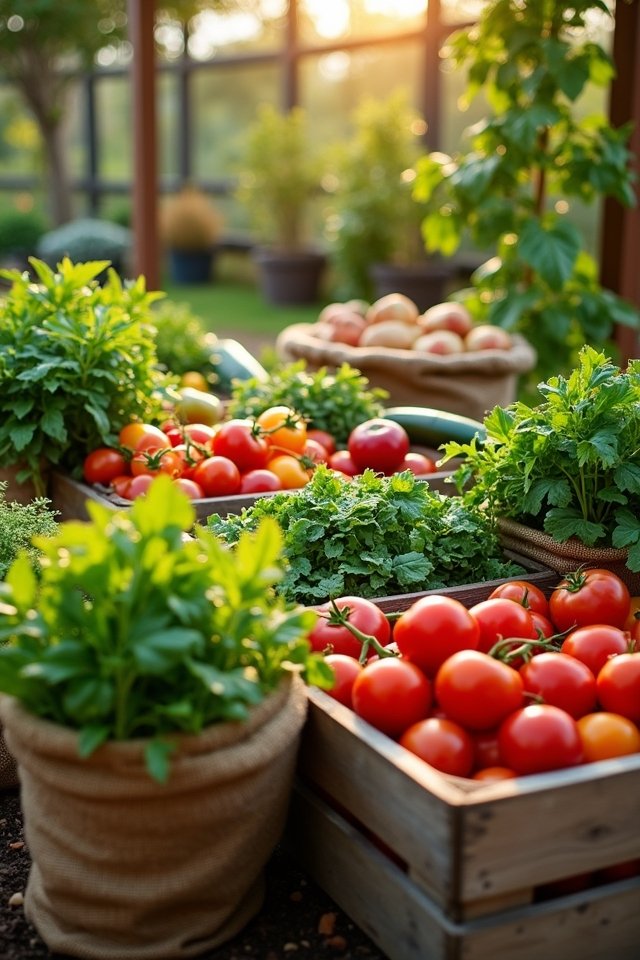
As your veggies reach their prime, don’t let them sit around like wallflowers at a dance! Harvest your crops right when they hit peak maturity for that delicious crunch or savory flavor you’re after. Picture biting into a ripe tomato bursting with summer sunshine! Use innovative storage techniques like keeping leafy greens in breathable bags wrapped with a damp cloth. Ever tried freezing shredded zucchini for winter soups? It’s a game changer! Label your containers to avoid confusion, and store your harvest in a cool, dark place. Remember, the sooner you store your crops, the fresher they taste! So, gather that bounty, and transform it into delightful meals that make your taste buds sing! What’s cooking tonight?
Frequently Asked Questions
Can I Grow Vegetables Year-Round in Containers?
Absolutely, you can grow vegetables year-round in containers! Just think of your pots as portable gardens! Consider climate—if it’s chilly, opt for heartier varieties like kale or carrots. You’ll be amazed by the vibrant colors! During warmer months, try summer favorites like tomatoes and peppers. Just like a well-timed joke, timing’s everything! So, with a little planning and creativity, your edible paradise can thrive all year long! How delicious is that?
How Do I Prevent Soil Compaction in Containers?
Ever thought about your plants feeling cramped? To prevent soil compaction, integrate innovative drainage techniques like adding perlite or vermiculite for that light, fluffy texture! You can mix in organic soil amendments like compost for nutrients and aeration, too. Don’t forget to gently aerate the soil by poking it with a stick now and then—your veggies will breathe easier, and grow stronger! Healthy roots equal healthier plants! Isn’t that what we all want?
What Are the Best Vegetables for Small Containers?
When choosing vegetables for small containers, think about container size and quick-growing selections! Imagine plump cherry tomatoes, vibrant green basil, or crisp radishes—these beauties thrive in tight spaces. You’ll love the thrill of snipping fresh herbs right from your porch! Plus, dwarf varieties of peppers and compact carrots work wonders. So, why not turn that tiny pot into a mini vegetable paradise? Try it, and watch your garden dreams bloom!
How Often Should I Rotate My Container Plants?
You should rotate your container plants every few weeks to keep them thriving! Think of it like giving your veggies a mini vacation. By switching their spots, you promote container health and avoid nutrient depletion. For instance, if you’ve got tomatoes and basil, swapping their places helps prevent pests from getting too cozy. Plus, it keeps your greens curious about their surroundings—no boring plants here! Happy rotating! Your plants will thank you!
Can I Reuse Potting Soil for New Crops?
Sure, you can reuse potting soil, but it’s not like giving your plants a buffet! Over time, that soil gets drained of nutrients. Think of it like an old sponge—dried out and lacking flavor. To breathe some life back, mix in fresh compost or slow-release fertilizers. That’ll keep your crops happy! Just remember, if the soil smells funky or has pests, it’s time to toss it! Your plants deserve the best!
